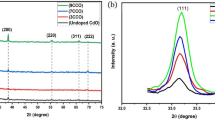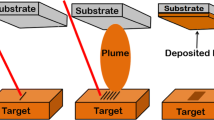2
, CO2, H2O or C2H5OH mixed with nitrogen gas; H2–Ar2 mixture) were applied in this study. Only the presence of ethanol vapour or water vapour helped to produce nano-holes when positive voltage pulse were superimposed on the sample. Furthermore, the existence of the critical vapour pressure of H2O or C2H5OH in the box was important in the modification of the gold surface and the etching process had an unitary rate when above critical vapour pressure. The linear relationship between the hole surface and the pulse duration was observed. We suggest that an anodic oxidation process of the gold surface under a voltage pulse and a place-exchange mechanism, involving the lifting of gold atoms in the surface monolayer, are relevant in nano-hole formation on the gold surface with STM. This process assisted by atom diffusion, due to the electric field built between the tip and the sample during the voltage pulse, explains the exceptional nano-hole geometry.
Similar content being viewed by others

Author information
Authors and Affiliations
Additional information
Received: 25 July 1997/Accepted: 1 October 1997
Rights and permissions
About this article
Cite this article
Lebreton, C., Wang, Z. Nano-hole formation on gold surface using scanning tunnelling microscope . Appl Phys A 66 (Suppl 1), S777–S782 (1998). https://doi.org/10.1007/s003390051241
Issue Date:
DOI: https://doi.org/10.1007/s003390051241



